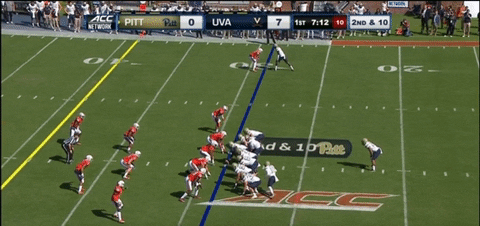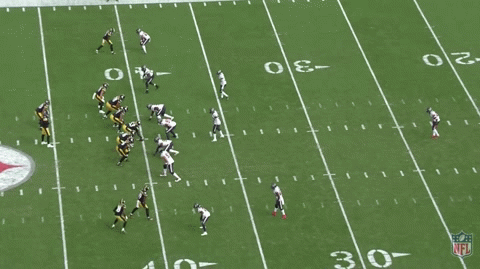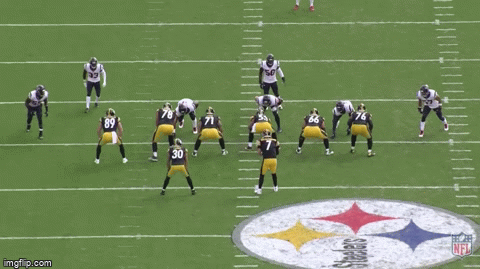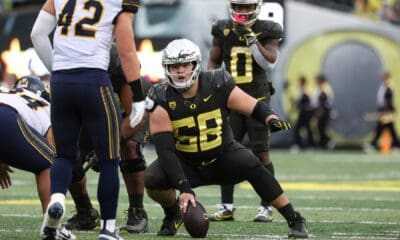Steelers Analysis
Film Study: Steelers Motion Scheme Providing Important, if Not Obvious Advantages

The Steelers’ running game figured to get a decent facelift this offseason with the addition of new quarterbacks coach Matt Canada to the team’s offensive braintrust.
While the addition of a quarterbacks coach helping the running game might seem somewhat nonsensical at first, it’s more about a significant philosophy that Canada brought with him from the college ranks that can impact both passing and running downs.
What Canada did as offensive coordinator at places like Pitt, LSU and Maryland was leverage pre-snap shifts and at-snap motion to force defenses into revealing their coverage scheme to the quarterback, create mismatches and get defenders out of their optimal alignments.
Here’s a play from Canada’s time at Pitt in 2016 as an example. Closely watch Virginia’s right inside linebacker, No. 51. He takes a crabbing step to his right as Quadree Henderson comes back across the formation before flowing to the hole behind Pitt’s right guard. As a result of that slight hesitation, he meets James Conner at an angle instead of more head-on and can’t make the tackle, turning a 4-yard gain into a 14-yard gain.

While there’s some shoddy technique all around from the Virginia linebackers on that play, the same concept of the motion causing a delayed reaction or a slight misstep in the defense, particularly linebackers, can work in the NFL.
Here’s a play from the Steelers’ Week 3 win over the Houston Texans. The Steelers are in 11 personnel and Houston is in a type of a 3-3-5 Nickel alignment, with cornerback A.J. Moore lined up as a strong safety, strong safety Eric Murray over JuJu Smith-Schuster far to the field and free safety Justin Reid playing center field. The play is a power run to the right for James Conner.
Diontae Johnson goes in motion across the formation at the snap, and cornerback Bradley Roby goes with him, leaving Murray alone with Smith-Schuster on the outside. This is a mismatch, and Murray seems to know it, immediately giving three yards as Smith-Schuster comes out of his stance before reacting to it being a running play. The extra distance takes Murray farther from the ball and makes it easier for Smith-Schuster to block him in space.

Murray isn’t the only player impacted by the motion on the Houston defense. Middle linebacker Tyrell Adams comes crashing forward at the snap, and then has to backtrack ever so slightly in order to loop around the left side of his line and fill an outside gap. The Steelers never end up blocking Adams, with Conner forcing him to fill the gap outside pulling tight end Vance McDonald before cutting it back inside of pulling guard Matt Feiler.
Adams’ extra step forward doesn’t look like a lot, but imagine how the end of this play would have changed if he was a stride ahead of Conner in getting outside the formation.
“As human beings and football players, especially defensively, we’re reactionary, and vision has a lot to do with that reaction,” McDonald said on Thursday. “It’s the dominant sense, obviously, that they’re using, especially at linebacker, and so not only are they lining their defense up, echoing and giving calls out, but they’re having to watch all this at the same time, all the film study and everything they do beforehand, that’s good for going into that game all accounts for something that can distract them, something that can pull them away from their gap, even if it’s a half step. You know, the saying goes in football, a blade of grass is a blade of grass, and we need every every one of them.”
Similarly, Reid’s first two steps were to his right, along with the motion of Johnson, which can be clearly seen from the end zone angle. Since it’s Reid that ends up making the tackle after Conner cuts inside, it’s safe to say those two steps gave the Steelers a yard or two.

The Steelers have be doing a lot of the type of motion seen in these plays. According to Seth Walder of ESPN, they’ve had motion at the snap 18.8% of the time this season, which is the sixth-most in the NFL. The Baltimore Ravens lead the league with 37.5% at-snap motions. Interestingly enough, of the six teams that use the most at-snap motion, the Steelers, Buffalo Bills and Green Bay Packers have started the season undefeated, the Ravens and Los Angeles Rams have one loss and only 1-3 Washington (21.2% at-snap motion) is below .500.
So far, the Steelers proclivity for pre-snap motions and shifts have not created a host of missed assignments or obviously blown coverages by opposing defenses. But the benefits are there, and even if they don’t come especially frequently, they provide more than enough reason to continue the program.
“Even if it’s one snap out of … 65 for offense, that a defensive player is out of a gap, or they’re half a second slower to that responsibility, it’s an edge for us,” McDonald said. “So I think, honestly, for me, my own personal opinion, we could do even more of it.”













